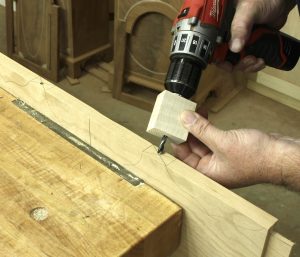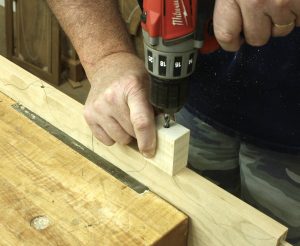We may receive a commission when you use our affiliate links. However, this does not impact our recommendations.
 If you’ve been around woodworking as long as I have, then this technique to drill holes straight is surely “old hat.” While it is an oldie, it is also a goodie, especially if you don’t have or cannot fit your workpiece under a drill press.
If you’ve been around woodworking as long as I have, then this technique to drill holes straight is surely “old hat.” While it is an oldie, it is also a goodie, especially if you don’t have or cannot fit your workpiece under a drill press.
When working on the lowboy discovered in the back room at the Connecticut Historical Society, I set up to drill a couple of holes in the front lower rail. Instead of clamping a fence in position at my drill press, I grabbed a small block to use as a guide. Why I drilled the holes for the two drop finials this early in the game is to head off a problem I had as I assembled the Queen Anne Dressing Table in the June 2010 issue (#183).
 In that build, as I clamped together the front, my clamp pressure snapped the highly cutout apron. As you may have guessed, it was a mad scramble to get things right before problems set in (glue dried). This time, I have a plan on how to head off such problems. You’ll need to read the article to learn my plan – it does involve the finial holes.
In that build, as I clamped together the front, my clamp pressure snapped the highly cutout apron. As you may have guessed, it was a mad scramble to get things right before problems set in (glue dried). This time, I have a plan on how to head off such problems. You’ll need to read the article to learn my plan – it does involve the finial holes.
To use this technique, you need a small block that is cut square. Carefully drill through the block – I have a drill press so I used it, but if you’re sans a press, use a square and check from all angles as you slowly drill. With the block ready, line up the tip of your bit with your layout mark (I simply Xd across my stock), hold the block firmly against the workpiece then drill down square and straight. The block acts as a guide.
For 100 different methods of work to make the process of woodworking easier, grab a copy of Marc Adams Technical Technique Video Series.
Here are some supplies and tools we find essential in our everyday work around the shop. We may receive a commission from sales referred by our links; however, we have carefully selected these products for their usefulness and quality.








If you don’t have a drill press, use a dowel jig to drill a perpendicular hole in the block. Much more accurate and clean than eyeballing with a square. For an angle, after drilling using the dowel jug, cut the block with angle desired, Every hole should be close to perfect.
Its also how you make drill stops for hand held drills, just cut the blank to length so the drill can be 1) mounted securely in the chuck and 2) just enough drill sticks out to make the hole deep enough. You can adjust the hole depth within a small range depending on how deep you put the drill into the chuck.
I learnt this from my grandfather, who started his working life making wooden boxes around 1900.
And if you put two pins/nails in on the diagonal line, you can set the drill to make the hole on the centre line of any job that fits between the pins.
Always chuckle when I hear guys talk about burning up their scrap pile, Great way to loose hundreds of jigs
This good tip also works great for angled holes such as a wall mounted coat or tool rack that is longer than the depth of your drill press.. It works best with a drill press of course but if the angle isn’t critical you can just eyeball it.
GREAT tip! Thanks.